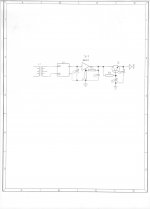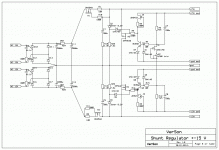OK, so if IC regulators are "too noisy", how about an example(s) of a discrete design that's superior to IC regulators with out giving away too many "secrets"?
While I enjoy following this thread, with the exception of the posts about blenders, I don't see many actual circuits posted and discussed.
If some of the circuits or patented or trademarked, then I can understand their not being posted.
When it comes to power supply circuits for preamps, mostly what I see are people talking about the "Salas" regulators or the Walter Jung "super regulator".
There's bound to be other great regulated p.s. circuits out there, but I guess finding them is the trick.
While I enjoy following this thread, with the exception of the posts about blenders, I don't see many actual circuits posted and discussed.
If some of the circuits or patented or trademarked, then I can understand their not being posted.
When it comes to power supply circuits for preamps, mostly what I see are people talking about the "Salas" regulators or the Walter Jung "super regulator".
There's bound to be other great regulated p.s. circuits out there, but I guess finding them is the trick.
Lets not end with unsupported claims and thoughts. I have much simpler explanation, re HF content. Intrinsic + cartridge distortion make products above 20kHz. Take a 16kHz test record and you will see 32kHz 2nd harmonic - always, with any cartridge.
However, there is quite a lot of musical content above 12kHz in the sample I have posted. To verify, just apply sharp DSP high pass filter and then listen to the result.
If the original was recorded in the 1960's then you should go back to the performance of the recording chain used to see if what you see is even possible.
A 1960's era reel to reel recorder optimized for SNR would not necessarily make it much past 18 KHz and with a bass rolloff as well. However microphones in use then and even today for recording have a sharp rolloff before 20 KHz. Often as low as 15 KHz. The dimensions of the diaphragm will be the first limiting element.
There is some good info out there on the acoustic spectra of various instruments and measurements of recording microphones. The former can't be done properly with the latter. I believe the spectral measurements were made with a 1/4" B&K. The 1/4" B&K however has an unacceptably high noise floor for music recording.
Gauging human sensitivity to the ultrasonic stuff is not easy. You need to have really accurate recording and reproducing chains with validated response to 50 KHz or 100 KHz to be able to test if its audible. And no peeking if its a real test.
However the extended response will probably bring a lot of other distortions and artifacts down simply from making it all work.
Hehe ! I used-it too for power amps.Here is a simple example of what I do.
Caps multiplier is, indeed, a good way to bring isolation, reduce noise and get rid of some evils of serial regulations (those with a lot of global feedback) with reproduction of fast transients.
Can look strange to add them after a regulation, but that's clever.
Some regulated SMPS on the DIY market are lower priced than their unregulated counterparts. I found it was a good way to get a better sound and lower switching noise out of them.
For power amps, my preferences are, by decreasing order:
- Cap multiplier (after anything you want, big PSU, SMPS, regulated or not).
- Unregulated SMPS.
- Unregulated oversized PSUs.
- Regulated SMPS.
- Regulated linear.
For preamp, and on my opinion, the main problem comes with AC leakeages from the transformer to the earth/ground. Currents across the grounds between components of your system. Specialy with asymetrical lines.
The ultimate solution is batteries and no other connection to the AC plug than the power amp, while you listen to music. Optical digital connection are better on this point of view.
Last edited:
Caps multiplier is, indeed, a good way to bring isolation, reduce noise and get rid of some evils of serial regulations (those with a lot of global feedback) with reproduction of fast transients.
Have you compared or listened to the effect of different transistor speed? In your capmult, you paralleled small, fast but obsolete darlingtons. Then, why darlingtons?
I have many TO-3 zeners suitable for power amplifier applications. Do you think they are usable?
Knowing that i only use CFAs power amps (faster but lower PSRR), my experience, limited to this context, is: The faster the better.Have you compared or listened to the effect of different transistor speed? I have many TO-3 zeners suitable for power amplifier applications. Do you think they are usable?
In an ideal world, if any regulation PSU side, rail regulation has to be faster than the amp itself.
I mean, if the cap multiplier is slow, we depend of the output cap impedance at HF. With other words, we hear the cap ;-)
Darlington or not, (I don't use Darlington in my own amp, but BDY66, BDY67) it is not so important, as long as you have enough current gain.
If you parallel a zener (or any other voltage reference) to the reference of a cap multiplier, in order to build a stabilized power supply and protect your amp from over voltages, the only concern is the noise they can produce. With your TO3 zeners and enough current across them, you certainly don't need darlingtons.
Last edited:
Darlington or not, (I don't use Darlington in my own amp, but BDY66, BDY67) it is not so important, as long as you have enough current gain.
If you parallel a zener (or any other voltage reference) to the reference of a cap multiplier, in order to build a stabilized power supply and protect your amp from over voltages, the only concern is the noise they can produce. With your TO3 zeners and enough current across them, you certainly don't need darlingtons.
Okay, I mixed up BDY66 with similar darlington marking. But I believe they are of similar small size (kind of TO-220). But if it is a bipolar, did you have any reason not to use C5200 so you don't have to parallel them?
As for the TO-3 zeners, I was thinking a different implementation than the capmult. Simply dropping the power zener in front of an unregulated supply, for example, what will the result be? Haven't seen such implementation tho.
Re quality of new an old recordings, this is a sample from 48 years old vinyl
https://www.dropbox.com/s/6ing6d2gkp7klh4/ella_short.wav?dl=0
It is recorded from
http://www.discogs.com/Ella-Fitzger...And-His-Orchestra-Whisper-Not/release/3024689
at 96kHz sampling. Still contains frequencies above 20 kHz. And enjoy dynamics of this stone age record.
I've had a listen to this, and although its not the style of music I would normally listen to, I can well appreciate the musical end result. Rock steady image... and in many ways its everything a recording "should" be. Its pleasing... yes ?
Lets not end with unsupported claims and thoughts. I have much simpler explanation, re HF content. Intrinsic + cartridge distortion make products above 20kHz. Take a 16kHz test record and you will see 32kHz 2nd harmonic - always, with any cartridge.
However, there is quite a lot of musical content above 12kHz in the sample I have posted. To verify, just apply sharp DSP high pass filter and then listen to the result.
All that really matters is that the recording "works" and produces a really enjoyable result.
I like that old mastering, quite natural sound. No DSP and no loudness wars. We have transparent digital + horrible mastering practices. Only classical music makes an exception.
Pavel, are you are becoming a subjectivist ?
Something to think on, lets turn all that on its head and look at the amplification chain... why is it so wrong then to design amplifiers based heavily on their subjective performance when the alternative approach of chasing down numbers doesn't always satisfy the listener ?
Many strive for technical perfection at the expense of the final result, which is simply to sit back and enjoy the music.
You have taken as a starting point a recording that, because of all its imperfections, delivers the goods sonically. Its an extreme example but what I am trying to say is that by sympathetic design in the amplification chain, you can often get that "magic" on recordings that are deficient for what ever reason. To me, the good amplifier is the one that makes 95% of a listeners record collection enjoyable, not the amplifier that has that listener seeking out those 5% of recordings that make it sound good. It can be done, but not in my experience by playing a numbers game.
Mooly, how does one express "a quite natural sound" in objectivist terms?
That's one to ask Pavel
Mooly, how does one express "a quite natural sound" in objectivist terms?
Even in subjectivist term I don't have a clue
Different recording techniques and presumably the equipment used is quite important to me in choosing recordings, and which of those end up being my favourites.
Come and have a listen to some short samples
http://www.diyaudio.com/forums/everything-else/265280-based-listening-do-you-prefer.html
Come and have a listen to some short samples
http://www.diyaudio.com/forums/everything-else/265280-based-listening-do-you-prefer.html
Gauging human sensitivity to the ultrasonic stuff is not easy. You need to have really accurate recording and reproducing chains with validated response to 50 KHz or 100 KHz to be able to test if its audible. And no peeking if its a real test.
Careful tests where spuriae were eliminated (signal chain misbehavior that mixes down in frequency is very hard to manage) show no ultrasonic audibility >20k.
Last edited:
- Status
- Not open for further replies.
- Home
- Member Areas
- The Lounge
- John Curl's Blowtorch preamplifier part II

